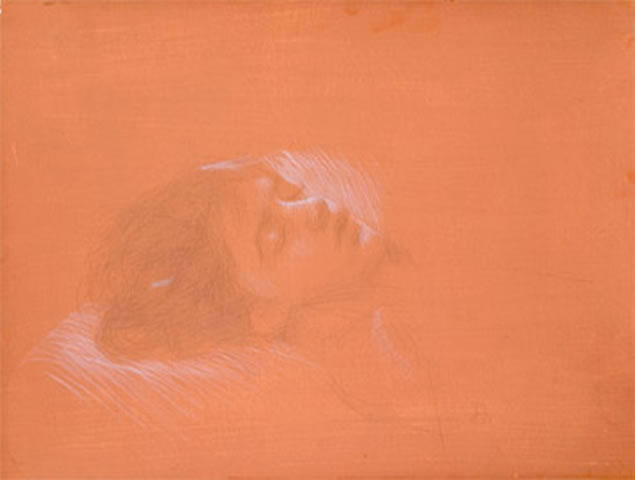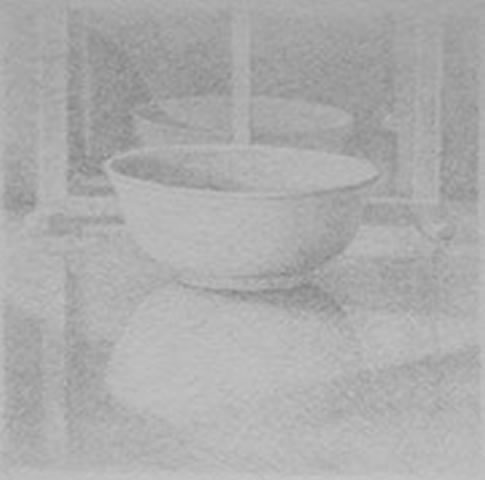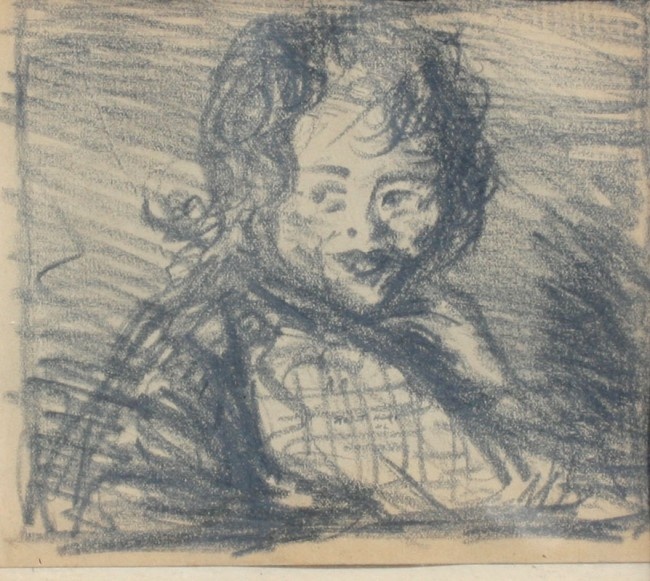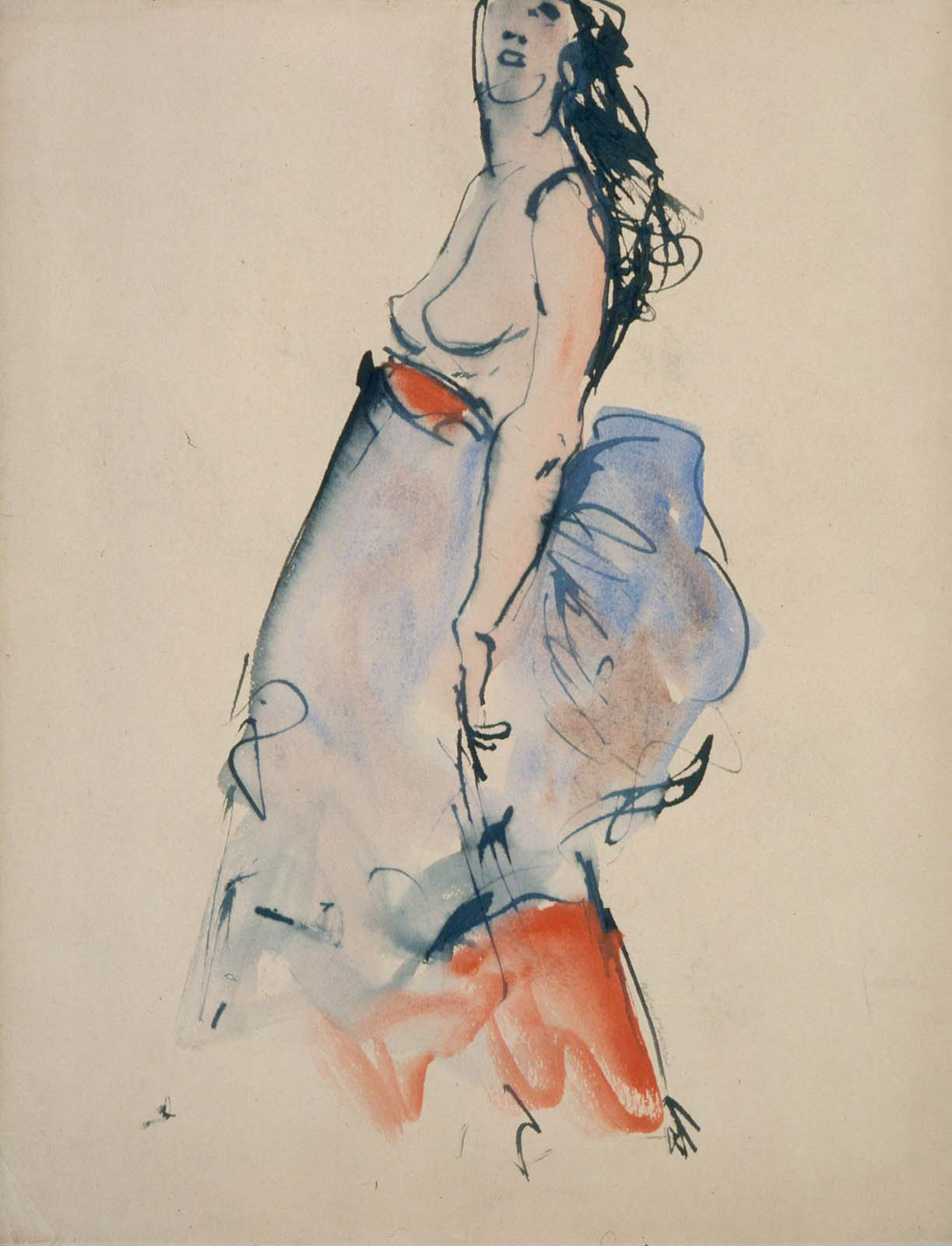As I looked at portraits of 17th century Spanish royal ladies in the Prado, they suddenly offered a fascinating sampling of how women fasten their dresses. Not for them a simple method of closing their dress. Rather, the fastening became part of the bold, imaginative design of the gown, part of the message of power, wealth and circumstance that was so dazzlingly recorded in paint by Court painters.
Read MorePortraiture
Lines of Joy /
On the eve of Christmas celebrations, I was delighted to receive my copy of the hardcover and beautifully presented catalogue of the Silverpoint Exhibitionat The National Arts Club in which my work was included. Looking through it, savouring of all the images of the drawings, I could not help thinking of a quote I had seen from Robert Henri: "All real works of art look as though they were done in joy."
Many of the silverpoints included in the exhibition were indeed drawn in joy, it seemed. Tender, loving joy in the case of Maddie Asleep by Ephraim Rubenstein, for example.
Joy of careful, sensitive observation and quiet in this drawing:
Joy of form and line in this highly polished self-portrait, by Lauren Amalia Redding.
Joy of honest scrutiny and realism in this portrait.
Joy of quiet stillness and creative attention in the still life drawings of Jeffrey Lewis and Tom Mazzullo.
Considering that a silverpoint drawing is a demanding, distinctly inflexible affair, it is remarkable how many of the drawings that were selected in the National Arts Club exhibition are fluid, assured works that speak of a clear objective, reached with practised lines that sing. Line built up on line, exploring, pushing out from the previous notation to record what the eye, the head, the heart and the hand all perceive. Many of us artists, when we talk of drawing in silver, mention this meditative aspect of the medium. And in that quietness and, often, solitude, there is deep joy, as the subtle lines weave a web of timelessness.
Curator and participating artist, Sherry Camhy, also included a fascinating conversation with Dr. Bruce Weber in the Silverpoint Exhibition book. Dr. Weber had put silverpoint back on the art world map in the United States in 1985 when he curated The Fine Line at the Norton Museum of Art in Palm Beach, Florida. He talked with Sherry of the integrity of drawings done in silver, emphasising the importance of being true unto the medium. Gerhard Richter talked of this same aspect of art: "I believe that art has a kind of rightness, as in music, when we hear whether or not a note is false."
Sherry Camhy selected silverpoint drawings that ring true, that speak of joy in execution. They are drawings of many diverse subjects, approaches and contexts, but they form a shimmering song to the discipline of draughtsmanship.
A Sense of Things /
The Telfair Museum in Savannah is currently showing a vibrant collection of Robert Henri's portraits done in Spain, Spanish Sojourns: Robert Henri and the Spirit of Spain. Henri was an important American artist in the early 20th century realist Ashcan Movement. He excelled at portraiture, was a noted teacher and left an extensive, wide-ranging body of work.
The Telfair exhibition captures the flash, bravado and complexity of Spanish culture, as Henri experienced it during his seven visits there between 1900 and 1926. His often full length portraits of dancers, gypsies, bullfighters and peasants convey a bold sense of each sitter's individuality, a sense of that person at that moment in time.
Robert Henri himself remarked, "Drawing is not following a line on the model; it is drawing your sense of the thing." His drawings are often succinct, but they do convey that sense of what he saw and experienced. His paintings capture the same feeling, as he clearly drew with his paintbrush as well as with other media. There is a fascinating and extensive collection of Henri's paintings and a few drawings at Poul Webb's blog, Art & Artists, and as you scroll through the images, each portrait is indeed clearly of an individual, However, as always, I tend to gravitate to the drawings and landscapes, rather than the portraiture. They often seem more powerfully to capture Henri's own dictum about the "sense of the thing".
Robert Henri, 1906 Procession in Spain, oil on canvas, Private collection
Yet, despite all the serious drawing and painting he did, one of the delicious comments that Henri left is this drawing.
He certainly caught the sense of things!
An Admirable Art Project /
On Morning Edition this morning, I heard of a really wonderful art project. Artist Matthew Mitchell, whose studio is in Amherst, Mass, is painting One Hundred Faces of War. Apparently one third of the way through the project, he is doing portraits of men and women who have served in the military in recent times, from very different ranks and varied walks of civilian life. He reflects the faces of veterans of Iraq and Afghanistan, people who have chosen to journey forth from America to these distant lands. Accompanying the very accomplished portraits, some posthumous, are statements written by the people themselves or by their survivors.
This project struck me as brilliant, not only because it is a wonderful way to make one's way professionally as an artist, with all the attendant publicity and exhibitions, but also because it seems a very necessary and important thing to do for society in general. As artist Mitchell remarked himself in the NPR interview, he did not know people in the military when he started out on this project. This is very frequently the case, I suspect. Certainly I do not know many people who have served in recent conflicts. In countries such as the US, where conscription has been abolished, the general awareness, on a personal level, of matters military is far more limited.
Nonetheless, America has a large number of very dedicated and admirable citizens who have served or are now serving; Iraq and Afghanistan are both terrible crucibles for these volunteers. I frequently have the uncomfortable feeling that their sacrifices are not always recognised sufficiently. Thus the Hundred Faces of War project is a wonderful way to convey to a wider public just what being a soldier means to men and women today. The portraits shown on Mr. Mitchell's website are eloquent and moving, made even more meaningful by the accompanying written statements.
Emilio Fernandez, IT Project Manager at the Veteran's Administration, From Phoenix, AZ, Marine, Sergeant, Artillery Fire Directional Controlman / Watch Chief, Iraq 2/03-6/03, 2/04-4/04 (Image courtesy of artist Matthew Miller), for Emilio Fernandez' statement, see http://100facesofwarexperience.org/portrait-gallery/100-faces/17229798
For artists, finding such projects is important but not always easy. Each of us has passions and concerns, and when the stars align to allow a project that combines our passion and our artistic skills, the results are usually powerful. The ventures are as diverse as are the artists involved - from a personal odyssey depicted in a series to plein air work done to raise awareness of an area's importance or an abstract exploration of feelings or memories... Each time one dreams up a project to execute, there is a thrill of excitement, often apprehension (as Matthew Mitchell also recognised in his NPR interview) about being able to tackle the task, but then a certain impetus and logic of the project itself seem to take over. One just goes about trying to execute it to the best of one's ability. Depending on the size and ambition of the project, it can become life-consuming. There is, nonetheless, an almost certain personal enrichment involved too. I have found that fascinations, insights, diverse joys and fresh knowledge come from each such venture - unexpected bonuses that remain with one. They often lead to the next project too, just as research for a book yields additional avenues later to be explored for other books.
I found the NPR story about Matthew Mitchell to be inspiring and reassuring - a timely reminder to be thinking of my next artwork series. I wonder if anyone else felt the same thing after hearing about him?
















